By: Louis J. Tofari
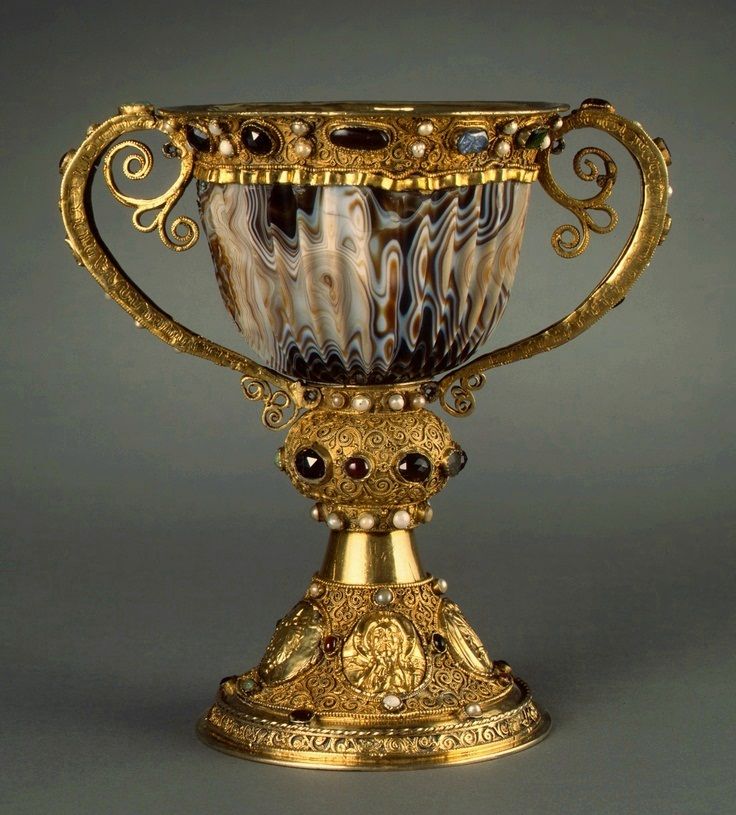
I went with my family to a Novus Ordo Mass. (I prefer the TLM for its silence and reverence. But sadly, I made the exception as I wanted to be with them.) During the Consecration, I noticed that the priest used what appeared to be a big (approx. 12”) clear glass or plastic bowl as the “Ciborium,” which contained the breads/hosts about to be consecrated. And, he eventually distributed Holy Communion from it.
What are the rules to that effect? And, what are my responsibilities, as a lay person when I witness something like that happening? Kindly confront/inform the priest?
*********************************************************************
Thank you for your question concerning the dignity of the vessels that should be used for the Sacred Species.
For starters it should be noted that historically for the making of sacred vessels (e.g., the chalice, paten and pyx) many types of materials have been used including wood, stone, ivory, glass, rock crystal and even earthenware.[1] In fact, today’s liturgical Latin term “pyx”—meaning any type of vessel used for reserving the Blessed Sacrament—originally referred to an ornamented box made of costly woods which was commonly used in earlier times for storing the Viaticum.
 Concerning the use of glass specifically, in the Early Church and up to the Middle Ages, patens and chalice cups were sometimes made of glass or rock crystal (and even precious stone such as the Valencia Chalice made from agate and chalcedony [2]), since this ancient type of glassware was expensive to produce and highly prized for its exquisite workmanship. One such famous example was the recently discovered Castulo Paten (see the picture, right). Thus these types of materials were considered within the ancient Roman Empire to be of noble and dignified character.
Concerning the use of glass specifically, in the Early Church and up to the Middle Ages, patens and chalice cups were sometimes made of glass or rock crystal (and even precious stone such as the Valencia Chalice made from agate and chalcedony [2]), since this ancient type of glassware was expensive to produce and highly prized for its exquisite workmanship. One such famous example was the recently discovered Castulo Paten (see the picture, right). Thus these types of materials were considered within the ancient Roman Empire to be of noble and dignified character.
Throughout the centuries, the Catholic Church continued to develop and refine its liturgical practices—often hand-in-hand with theological clarifications—not only to avoid possible abuses, but also to ensure that the best material requisites were being used in the worship of Almighty God.
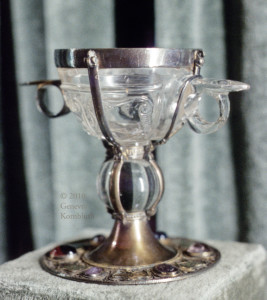
To our case in point, eventually the use of glass and crystal patens and chalice cups were forbidden in the Latin Church, as these were prone to chipping or breakage, hence lacking the durability required of sacred vessels, especially ones used daily. Eventually, it was prescribed throughout the Latin Church that only two types of materials should come into direct contact with the Sacred Species: gold and linen (i.e., the corporal, pall and purificator).[3]
Concerning the requirement of gold for sacred vessels, whatever part comes into direct contact with the Sacred Species (e.g., the top or shallow side of the paten and inner part of the chalice cup) must be gilded, though the external parts may be made of other materials (e.g., silver, brass, ivory, etc.) and decorated with jewels and enamels. This gilding rule also applies to any other sacred vessel used for reserving the Blessed Sacrament such as the ciborium, sick call pyx, luna and monstrance.[4]
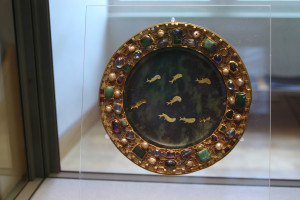
The choice for the use of gold reflects the fact that God Himself commanded the Israelites to use this precious metal throughout the Tabernacle of the Wilderness and later the Temple of Jerusalem, not only for the ceremonial vessels (e.g., the Ark of the Covenant, the Altar of Incense, the Menorah, etc.), but even for the interiors of the Holies and Holy of Holies. Also in the natural order of things, gold is an ideal metal since it is resistant to tarnishing and corrosion, and relatively easy to maintain. Its quality of brightness also makes it easy to distinguish between the metallic surface and any possible Sacred Particles that might remain.
It is noteworthy that this prescription for gilded vessels that come into contact with the Sacred Species was a development that occurred almost simultaneously in both the East and the West, and was implemented to show the great dignity and reverence that is owed to the Sacred Body and Precious Blood of Jesus Christ.
With the advent of the Novus Ordo Missae, there occurred a great diminishing of the prescriptions that had been carefully established by the Latin Church over centuries, specifically to safeguard the dignity that belong to the Sacred Species, a matter that was decried as early as 1969 in the Ottaviani Intervention.[4] Many of these rubrical changes found in the New Mass were inspired by antiquarianism—and often in conjunction with the object of creating an ecumenical liturgy.[5]
This error—also known as “archaeologism”—consists of an exaggerated attachment to prior or more ancient practices which were considered by some to be purer than contemporary ones. Antiquarianism has actually existed since the Early Church, and was solemnly condemned in 1947 by Pope Pius XII in his encyclical, Mediator Dei (see the appendix below for the pertinent extract).
The laisse-faire atmosphere created by the Novus Ordo caused a wave of experimentation and further implementations of antiquarianism, such as the replacement of proper sacred vessels in preference to vessels made of inferior materials such as pewter, glass, ceramics and earthenware. To justify this liberal shift, several mantras have been echoed of which I present three for refutation:
- Jesus Christ used a wooden cup at the Last Supper, hence…
- Earthenware and glassware were used in the Early Church for Mass.
- Our liturgy should be simpler and identify itself better with the poor.
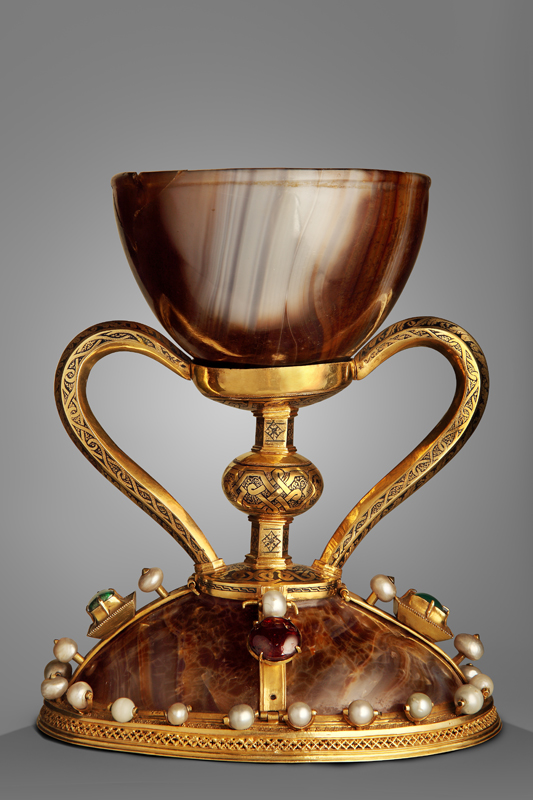
In answer to mantra #1, actually no one is really sure what Christ used as a chalice during the First Mass at the Last Supper. While a wooden cup (the supposed Holy Grail) is one tradition, another is the agate cup of the aforementioned Valencia Chalice (just one of several ancient chalices claimed to be the actual Holy Grail). That being said, Christ is God, so He could use what He pleased, but it seems probable that the cup He used was of better quality than an ordinary drinking goblet of the ancient world, particularly as the Last Supper was in connection with the Jewish Passover rite. On the other hand, we being poor creatures of God, ought to give our best to Him in the spirit of Abel versus that of Cain.
To mantra #2, the answer has already been given in that the Church herself, in her inspired wisdom, shifted the manufacture of sacred vessels as precious objects, not only to give respect to what is divine, but also to provide adequate safeguards. And though both gold and clay come from the dust created by God (and of which we also consist), nonetheless, God did command the Israelites to make use of more expensive gold for the worship of Him in the Temple, rather than less costly clay.
As for #3, this mantra seems more inspired by Marxist tenets rather than the example of the saints who were completely dedicated to the true spirit of evangelical poverty, such as St. Francis of Assisi and St. John Vianney. These saints were utterly attached to Lady Poverty, and yet had no compunction in using costly items for the worship of God through the Holy Sacrifice of the Mass.

In fact, St. John Vianney was renowned for purchasing sacred vessels and vestments of exquisite quality which are still preserved in his parish church of Ars (France). As for St. Francis, in addition to the gold chalice and paten that he handled while serving as a deacon at Mass (he was never ordained a priest) preserved in the Assisi basilica, a fortiori we have his admonition to custodians of churches:
I beg you, with all that is in me and more, that, when it is appropriate and you judge it profitable, you humbly beseech the clergy to revere above everything else the Most Holy Body and Blood of our Lord Jesus Christ and His holy written words which consecrate His Body.
The chalices, corporals, appointments of the altar, and everything that pertains to the sacrifice must be of precious material. And if the most holy Body of the Lord is very poorly reserved in any place, it should be placed in a precious location under lock and kept according to the mandate of the Church and carried about with great reverence and administered to others with discretion…[6]
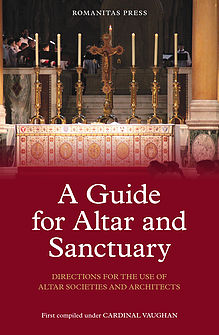
Furthermore, such a mantra that supposedly favors the poor (who as our Lord indicated we will always have with us) is rather hypocritical when we consider the million-dollar monstrosities that the spirit of the Novus Ordo has created, such as the infamous Los Angeles cathedral or the recent purchase of the Crystal Cathedral by the Orange Diocese, also in California.
Some further observations should be made concerning the use of glass vessels in the sacred liturgy. It is actually prescribed in the Roman Rite that the cruets—the vessels used to hold the wine and water—are to be made of clear glass or crystal so that the contents can be easily distinguished, though cruets of solid metal are tolerated.
Also, during the 20th century persecution of the Church in Mexico, Pope Pius XI gave many generous indults to the Mexican Catholics to allow them to continue practicing the Faith under severe conditions. One of these was a special indult to use a crystal or glass goblet for the celebration of Mass, but with the stipulation that immediately afterwards, the glass must be broken and its pieces buried so that it could not be used again for profane (secular) use.

In conclusion to this answer, you had asked what should be done in such situations where liturgical prescriptions (and traditional sanity) are not being obeyed in the Novus Ordo Missae. Unfortunately, there is not much that can be done, because even if clarifications have been given by ecclesiastical authorities on this matter, priests and laity often ignore them out of an attachment to liturgical novelty.
That being said, we can work to rectify this tragic situation in the Roman Catholic Church by promoting a return to her immemorial liturgical traditions and thus ultimately, the traditional Roman Mass. In addition to fervent prayer, we also have at our disposal the ability to charitably re-educate the clergy and faithful in the sanity of the traditional liturgy, and to this end, such books available from Romanitas Press as A Guide for Altar and Sanctuary and The Liturgical Altar can greatly assist (and in fact, this was partially the reason why I reprinted these two great compilations on important liturgical matters).
Footnotes
1 Perhaps the most well-known ceramic chalice is the one reputedly used by St. Jerome which had an earthenware cup and copper base. This was brought from Jerusalem to Rome and used to be displayed as a relic in the Minor Basilica of St. Anastasia in Rome.
2 Preserved in the Valencia Cathedral in Spain, the base of this chalice is made from chalcedony and is considered by some to be the actual Holy Grail used by Christ at the Last Supper.
3 Linen—also prescribed to be used in the Temple services and since ancient times considered a fabric of noble dignity—is also the ideal fabric due to its quality of high absorbency, resistance to soiling and friction, and lastly, because it will not scratch gold or silver.
4 The actual title of this document is “A Brief Critical Study of the New Order of Mass” which can be read in full here.
5 One such way that antiquarianism was used in this manner was to return to less developed practices towards the Blessed Sacrament (such as omitting genuflections) which would placate the disbelief of Protestants in the Real Presence. To support the antiquarianist view of reverencing the Blessed Sacrament, liberal liturgists cited the absence of the genuflection in the Eastern Rites, where only a bow is made. While in the Eastern Rites this practice is perfectly legitimate (as they never discontinued the more ancient, though less developed custom), in the Latin Church the genuflection has been used for immemorially for centuries, hence why its omission through the Novus Ordo has contributed to Roman Catholics no longer properly understanding the doctrine of the Real Presence.
6 This text is derived from the Opscula or collection of writing of St. Francis, particularly the edition of Fr. Lucas Wadding published in 1623 (here is the Google Books link) and later translated into English by Fr. Paschal Robinson as The Writings of Saint Francis of Assisi.
Appendix
Mediator Dei on Antiquariansim
- The same reasoning holds in the case of some persons who are bent on the restoration of all the ancient rites and ceremonies indiscriminately. The liturgy of the early ages is most certainly worthy of all veneration. But ancient usage must not be esteemed more suitable and proper, either in its own right or in its significance for later times and new situations, on the simple ground that it carries the savor and aroma of antiquity. The more recent liturgical rites likewise deserve reverence and respect. They, too, owe their inspiration to the Holy Spirit, who assists the Church in every age even to the consummation of the world.[52] They are equally the resources used by the majestic Spouse of Jesus Christ to promote and procure the sanctity of man.
- Assuredly it is a wise and most laudable thing to return in spirit and affection to the sources of the sacred liturgy. For research in this field of study, by tracing it back to its origins, contributes valuable assistance towards a more thorough and careful investigation of the significance of feast days, and of the meaning of the texts and sacred ceremonies employed on their occasion. But it is neither wise nor laudable to reduce everything to antiquity by every possible device. Thus, to cite some instances, one would be straying from the straight path were he to wish the altar restored to its primitive table form; were he to want black excluded as a color for the liturgical vestments; were he to forbid the use of sacred images and statues in churches; were he to order the crucifix so designed that the divine Redeemer’s body shows no trace of His cruel sufferings; and lastly were he to disdain and reject polyphonic music or singing in parts, even where it conforms to regulations issued by the Holy See.
- Clearly no sincere Catholic can refuse to accept the formulation of Christian doctrine more recently elaborated and proclaimed as dogmas by the Church, under the inspiration and guidance of the Holy Spirit with abundant fruit for souls, because it pleases him to hark back to the old formulas. No more can any Catholic in his right senses repudiate existing legislation of the Church to revert to prescriptions based on the earliest sources of canon law. Just as obviously unwise and mistaken is the zeal of one who in matters liturgical would go back to the rites and usage of antiquity, discarding the new patterns introduced by disposition of divine Providence to meet the changes of circumstances and situation.
- This way of acting bids fair to revive the exaggerated and senseless antiquarianism to which the illegal Council of Pistoia gave rise. It likewise attempts to reinstate a series of errors which were responsible for the calling of that meeting as well as for those resulting from it, with grievous harm to souls, and which the Church, the ever-watchful guardian of the “Deposit of Faith” committed to her charge by her divine Founder, had every right and reason to condemn.[53] For perverse designs and ventures of this sort tend to paralyze and weaken that process of sanctification by which the sacred liturgy directs the sons of adoption to their Heavenly Father of their souls’ salvation.
Mediator Dei, Footnotes cited
- Cf. Matt. 28:20.
- Cf. Pius VI, Constitution Auctorem fidei, August 28, 1794, nn. 31-34, 39, 62, 66, 69-74.

I hope the future of the liturgy resembles that of the reverential past.
I have more respect fro protestant “churches” who do not claim to believe in the Real Presence and behave accordingly then the N.O.
oops–I hit Post Comment by accident.
I have more respect for protestant “churches” who don’t claim to believe in the Real Presence (and behave accordingly) than for the N.O. establishment which says they DO believe but behave like they don’t. As far as the N.O. is concerned, beautiful sacred vessels for Holy Mass belong in a museum for the nostalgic.
“I went with my family to a Novus Ordo Mass.”
My heart bleeds for you. No one should attend an NO abomination except as penance for the worst sorts of sins.
As long as traditionally oriented minded Catholics keeping attaching legitimacy to the NO V2 sect, the restoration of Catholicism will be impeeded. One is truth and one is a lie.
Tom A. Your comment sums up why I am so bewildered why the SSPX seeks “regularization” from NO V2 and why they are so grateful for every crumb Bergoglio throws their way. Don’t they know they are legitimizing the very existence of the N.O. which is an instrument of the devil? I’m not getting it.
Its the operation of error. The lie is easier to believe than the truth.
I just read on another blog that its easier to fool people than it is to convince them they’ve been fooled. It wasn’t easy for me to admit that all I believed about the Church these past decades was a lie. Remember, the Truth leads a soul to the Cross. That is His path and ultimately ours.
Tom A–In other words, the priestly society established by Ab. Lefebrve to combat the N.O. “mess” has fallen into such grave error that now they a bowing before it. This is a very frightening scenario. Where do aka Catholics go who want to join the battle to “restore all things in Christ”?
“…We can work to rectify this tragic situation in the Roman Catholic Church by promoting a return to her immemorial liturgical traditions and thus ultimately, the traditional Roman Mass.”
Ultimately, there needs to be a return to Roman Catholicism, which seems highly unlikely today which is the necessary prerequisite for the liturgy as it is the prayer of the Church and expression of theology.
A return to Roman Catholicism necessarily requires a repudiation of the errors of Vatican II, particularly the error of Ecumenism which usurped the very mission given by Christ to His Church to go out into the world and teach the true Gospel in order to convert all men, everywhere and at all times, to the one, true, apostolic faith, and if one is honest, directed the Catholic to deny the true faith while esteeming, respecting, and honoring and confirming the errors of those who are enemies of Christ and work to expunge Him from the mind and heart of man.
Good Friday morning Tom A,
Indeed, particularly as it is incumbent upon the husband and father of the family to lead IN the Faith. This “accompaniment”, is nothing other than an enabling act, fostering a “human respect” in lieu of the glory due Almighty God, which can do absolutely nothing but yield credence to the abomination of desolation, which the “conciliar church” is, as the church of the Antichrist, as it can only be with metaphysical certainty. As rhetorically understood, “but why is that?”. Of course, it is because they (the Luciferians all dressed up in the robes of the Church) literally as actually, deny substantial being as Being Himself. In this denial, one Joseph Ratzinger as a principle denier his entire clerical career and having written extensively about it in a prose which many often do not grasp intellectively, the “Church” is simply seen from the reality of Her metaphysical “accidentals” and not from Her essential substance, as the Mystical Body of Christ Jesus our Lord, our God, and our King. See hyperlinked now, an article from 2012 by James Larson, republished at TIA, when Ratzinger still held as captive, the mirror image of the Chair of Saint Peter. Know that Larson remains blinded to the reality of the false popes having occupied the mirror image of the Chair since 1958, even while having written extensively through the lens of Thomistic metaphysics, on the errors of these men as teachers, which he continues to view as “Pope”, thus evidencing the internal contradiction of the “operation of error”. Let us pray for his conversion. Here is the hyperlink: http://www.traditioninaction.org/HotTopics/f058_Newman_3.htm
John Cardinal Newman is exposed for the mercenary that he was, as well. He evidenced an hatred for Pope Pius IX and his “Syllabus of Errors”, which condemned all of the realities of the age as the deceptions of Modernism. Note that it is part 3 of a three part article there, which is hyperlinked. In caritas.
Good Friday morning Katherine,
You witness the true, the beautiful, and the good. Amen. As you so beautifully edify, the Holy Sacrifice of the Mass is the highest liturgical expression of Holy Mother Church, as infinitely understood. That known with certitude, that Gregorian Rite of the Roman Missal, the only and singular True Roman Rite of the Holy and ineffable Sacrifice, as codified in Apostolic language by Saint Pope Pius V, can only be expressed by Christ’s Church, His Mystical Body and Bride. It cannot, with certitude, be expressed in reality as Reality from the “conciliar church”, as the church of the Antichrist, which it can only be, as it rests in the antithetical position of leading souls to hell and not to the Beatific Vision as understood res ipsa loquitur. In caritas.
Without bishops consecrated to the Latin Roman Rite there will be no Apostolic Succession and therefore no return to the Holy Sacrifice of the Mass as codified by the Council of Trent. Without Apostolic Succession the bishops do no receive the charism of episcopacy–that is why it is futile to look to bishops conscecrated to the Novus Ordo rite to teach the true Roman Catholic Faith. Pray for and encourage the SSPX to conditionally ordain all priests ordained to the Novus Ordo rite before serving as priests in SSPX chapels. Support priests and bishops who are ordained and consecrated in the Latin Roman Catholic Rite by bishops consecrated to that Rite!
As the late Father Carl Pulvermacher, OFM Cap. stated, “Once there are no more valid priests, they’ll permit the Latin Mass.”.
Dear coastalfarm,
Amen.
A good article, but I would have enjoyed it more if you showed some side by side pictures of what passes as sacred vessels in the apostate NO sect. This can clearly illustrate that they are two different faiths. For the NO sect prefers a utilitarian look while Catholicism knows that the vessel will hold the Body Blood Soul and Divinity of Our Lord. That is why the stark difference. NO vessels are bland and unadorned seeing how their faith is likewise. They have stripped out the Divine from their community meal so there is only symbolism remaining. For the good of your soul and that of your loved ones, please refrain from any further involvment with the liturgy of apostasy, AKA Novus Ordoland.
Blessed Anne Catherine Emmerich gave us some insight into the Chalice used by Christ at the Last Supper.
Her visions revealed that the Chalice was on the ark with Noah, was passed to Moses, used by priests and then was sold. It was purchased by St. Veronica (Seraphia) and given to Jesus.
It was “pear-shaped, and of a brownish, highly polished metal overlaid with gold.” It was now equipped with handles and a foot of “dark virgin gold, the edge encircled by a serpent,” embellished with jewels and a grape design. The Chalice, which contained a small vase and was covered by a plate, sat on a flat tray that concealed a tablet and was equipped with a spoon, linen covers, and a leather case. ‘Jesus alone knew of what it was made.”